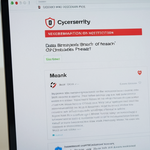
Security teams face an unprecedented challenge in distinguishing legitimate threats from the flood of misleading information that inundates dark web scanning platforms. In July 2025, CloudSEK revealed how misinformation and recycled breach data from forums, media, and researchers flood threat intelligence teams with false alarms, with approximately 25% of security teams’ time wasted on investigating noise rather than genuine threats. High-profile cases like the “16 Billion Credential Leak” and the Indian Council of Medical Research (ICMR) breach were severely inflated using old or fabricated data, demonstrating how duplicates and reposts have become a critical barrier to effective exposure monitoring and response. This comprehensive analysis examines the multifaceted problem of duplicate and reposted data in dark web scanning, exploring how this noise originates, propagates, and ultimately compromises the ability of organizations to prioritize genuine cybersecurity threats.
The Anatomy of Alert Noise in Dark Web Scanning Infrastructure
Dark web scanning and exposure monitoring services are designed to provide organizations with early warning of compromised credentials, leaked data, and unauthorized references of proprietary information across underground forums and marketplaces. However, the ecosystem that facilitates dark web monitoring has inadvertently created an environment where duplicates and reposts constitute a significant portion of alert volume, fundamentally degrading signal quality. Understanding the nature of this noise requires examining how data flows through the dark web ecosystem, from initial breach to resale and eventual reposting across multiple platforms.
Alert noise in the context of dark web scanning refers to false, misleading, or recycled data misrepresented as new breaches or threat disclosures. This noise takes multiple forms and originates from diverse sources. The three main categories of noise identified by threat intelligence researchers include overhyped or inflated claims regarding breach scope, sensationalized media reporting that amplifies unverified assertions, and deliberately misleading information propagated by threat actors seeking to attract attention or manipulate market dynamics. The problem extends beyond simple duplicates; it encompasses the repackaging of old data with inflated numbers, the fabrication of entirely fictional breaches, and the strategic reposting of credentials across multiple platforms to extend their perceived value and circulation. When operational teams dedicate substantial resources to investigating these false alarms, the opportunity cost becomes substantial, as genuine threats requiring immediate attention become deprioritized or missed entirely.
The scale of this problem has grown exponentially as the dark web marketplace has matured and as threat actors have developed increasingly sophisticated strategies for monetizing stolen data. A security team monitoring dark web forums must now contend not only with legitimate breach data but also with a complex ecosystem of deceptive practices that actively work against threat detection and response capabilities. The intersection of multiple factors—law enforcement disruptions creating market vacuums, competitive dynamics among forum operators, and the inherent economics of selling the same data multiple times—has created powerful incentives for the generation and distribution of duplicate and reposts throughout the threat intelligence supply chain.
The Forum Takedown Effect and the Birth of Duplicate Proliferation
One of the most significant factors driving the explosion of duplicates and reposts in dark web scanning data is the phenomenon known as the “forum takedown effect.” When law enforcement agencies successfully disrupt major underground forums, a power vacuum forms that rival platforms eagerly exploit. Rather than allowing the displaced users and data to migrate organically, competing forums have discovered that aggressively releasing “new” datasets—often recycled breaches offered ostensibly for free to boost user registration—creates a compelling reason for cybercriminals to establish accounts and participate in their communities. This dynamic has become a predictable pattern in the dark web ecosystem, with each major takedown triggering a cascade of duplicate releases designed to attract and retain users during transitional periods.
The May 2024 takedown of BreachForums by law enforcement represents a critical case study in how forum disruptions generate noise. When BreachForums was initially seized, a power vacuum formed that became the focal point for intense competition among successor platforms. In June 2025, French authorities arrested five key BreachForums operators, including the notorious threat actor “ShinyHunters” and “IntelBroker,” in coordinated raids across Paris, Normandy, and Réunion, further disrupting forum operations and intensifying the scramble among rival platforms to fill the void. During this period, competing forums such as DarkForums and LeakBase aggressively released datasets that had previously circulated on BreachForums or other sources, rebranding them as novel discoveries to attract users and establish market credibility.
This competitive dynamic creates several layers of noise that confound dark web monitoring systems. First, the same dataset appears simultaneously on multiple forums under different names or with slightly modified descriptions. Second, threat actors deliberately inflate the reported number of compromised records or add fabricated credentials to previously leaked datasets to increase apparent value and generate marketing interest. Third, the temporal distribution of these releases creates the impression of an ongoing surge in new breaches when in reality, much of the activity represents the same data being cycled through different platforms. For security teams using automated dark web monitoring tools that lack sophisticated deduplication capabilities, this creates an overwhelming torrent of apparent “new” threats that demand investigation despite representing no novel exposure.
The specific impact of the BreachForums disruptions illustrates this dynamic clearly. Following the forum’s repeated seizures and relocations, researchers documented a 600% surge in activity on DarkForums between April 1 and June 30, 2025, as the platform absorbed much of BreachForums’ displaced user base. However, analysis of the specific datasets released during this period revealed that a substantial portion consisted of previously known breaches and recycled credentials. Threat actors deliberately repackaged old data with new marketing language, falsified dates of compromise to make them appear recent, and combined datasets from different sources to create the appearance of novel, high-value information. The result was an explosion in dark web monitoring alerts across the industry, with organizations worldwide investigating what appeared to be new compromise events that actually represented dormant threat intelligence re-entering circulation.
Source Credibility and the Architecture of Misinformation
Not all sources of dark web data possess equal reliability, and threat actors have learned to exploit this reality by strategically manipulating source credibility and cultivating reputations for authenticity. Chinese dark web forums, particularly forums like Chang’an, have earned notoriety for systematically recycling old data while fabricating entirely fictional breaches with randomly generated organization names. This deliberate deception serves multiple purposes: it attracts users to the forum through the promise of novel, high-value information; it provides fodder for researchers and security vendors seeking sensational headlines; and it extends the apparent market value of recycled datasets by recontextualizing them within new narrative frameworks.
The mechanism of source credibility manipulation involves several sophisticated techniques. Threat actors build apparent credibility through the careful curation of data compilations, leveraging a combination of legitimate breached data alongside fabricated records to create comprehensive datasets that appear authoritative and valuable. Sensationalized headlines and marketing language create urgency and apparent importance, compelling security teams to prioritize investigation. Media outlets amplify this noise by uncritically reporting on unverified claims from researchers or threat actors, lending institutional credibility to assertions that lack substantiation. Researchers themselves sometimes contribute to noise proliferation by exaggerating findings or claiming unprecedented scope without adequate verification—the case of researchers claiming an “184 Million Credential Breach” exemplifies how dramatic headlines become detached from actual data quality or novelty.
This ecosystem of misinformation extends beyond intentional deception to include structural factors that incentivize noise generation. Security vendors have discovered that alarming threat intelligence generates media attention, which drives customer acquisition and retention. Researchers seeking professional advancement or attention find that sensational findings generate citations and media coverage. Media outlets pursuing engagement find that threat stories attract audience attention. And threat actors on the dark web have learned that sensational marketing generates sales interest, even when the underlying data offers limited novelty. Together, these incentive structures create a reinforcing cycle that systematically amplifies noise relative to signal.
The specific mechanics of source credibility manipulation merit detailed examination because they directly shape how dark web scanning tools must be configured to avoid false positives. Threat actors build credibility by maintaining consistent presence on forums over extended periods, cultivating reputations through successful transactions, and strategically releasing legitimately high-value information interspersed with recycled or fabricated data. Once a threat actor establishes reputation and credibility, their subsequent posts receive disproportionate attention and investigation from security teams, even when the underlying data quality has not changed. This reputation effect creates a perverse incentive structure where threat actors benefit from strategically mixing legitimate and fraudulent data, knowing that their established credibility will create investigation demand regardless of actual disclosure novelty.
The Free.fr and Boulanger Case Studies: Tracing Duplicates Through the Ecosystem
Real-world examples illuminate how duplicates and reposts function within the dark web ecosystem and demonstrate the mechanisms through which noise spreads through threat intelligence channels. The Free.fr breach, initially reported in October 2024, provides a particularly instructive example of how a legitimate security incident becomes systematically obscured through reposting, exaggeration, and re-contextualization across multiple platforms.
The incident began when threat actor “drussellx” discovered a vulnerability in Free.fr’s management tools, successfully exfiltrating data affecting 19.2 million customer accounts. The dataset included names, addresses, emails, phone numbers, and most significantly, 5.11 million IBANs—direct bank account identifiers representing extremely high-value information. The threat actor initially offered the dataset for $175,000, representing a legitimate high-value disclosure. However, the story did not end with this initial disclosure. Instead, it evolved into a case study of how legitimate breach data becomes degraded through duplication and re-packaging.
The threat actor’s initial attempt to monetize the data through sale generated limited success, leading to a strategic shift toward extortion rather than direct sale. The dataset was subsequently reposted on multiple dark web forums and Telegram channels, where various threat actors claimed ownership or described fictitious elements of the compromise. More significantly, the repackaged versions inflated the claimed number of compromised records from the verified 19.2 million to fabricated figures of “20 million accounts,” and added fake credentials to the dataset to increase its apparent value. The repackaged data fueled subsequent phishing campaigns and fraudulent activities, eroding trust in Free.fr’s handling of the incident and prompting regulatory scrutiny under GDPR compliance frameworks.
From the perspective of dark web monitoring and exposure response, the Free.fr case demonstrates several critical challenges. Organizations monitoring for Free.fr data exposure would have encountered multiple duplicate alerts across different forums and platforms, each claiming novelty or reporting slightly different compromise scope. Security teams would have needed to invest substantial effort in verifying whether each alert represented new exposure or constituted a repost of previously known information. The addition of fabricated credentials complicated the picture further, as automated systems comparing datasets could not definitively distinguish legitimate compromise data from falsified entries without manual forensic analysis. The temporal dynamics also created confusion, as the dataset circulated across multiple venues over an extended period, creating the impression of ongoing, expanding compromise when in reality the initial disclosure had been exhaustively circulated.
Similar dynamics emerged in the Boulanger case, where multiple threat actors reposted breach data with inflated compromise claims. These cases illustrate that duplicates and reposts do not simply create alert fatigue through volume; they actively degrade data quality and create false impressions about the scope and timeline of security incidents. Organizations attempting to prioritize remediation efforts based on dark web monitoring data face substantial challenges in distinguishing genuine new exposure from recycled information masquerading as novel threats.

Alert Fatigue and the Human Cost of Noise
The proliferation of duplicate and reposted data in dark web monitoring systems has cascading consequences for the security professionals tasked with investigating alerts and coordinating response efforts. Alert fatigue—the phenomenon wherein security teams become overwhelmed by the sheer volume of notifications and gradually develop diminished responsiveness to alerts—has emerged as a critical vulnerability in cybersecurity operations. The statistics documenting this crisis are sobering: approximately 74% of alerts received by IT and cloud operations teams constitute noise, with some organizations reporting false positive rates as high as 70%.
The personal and organizational consequences of alert fatigue extend far beyond productivity metrics. A 2025 survey revealed that 56% of security professionals feel exhausted by incoming alerts on a daily or weekly basis, with this percentage representing a worsening trend. More broadly, 76% of cybersecurity professionals reported experiencing cybersecurity fatigue or burnout either constantly, frequently, or occasionally over the preceding year, with 69% noting that fatigue and burnout increased from 2023 to 2024. This burnout manifests in concrete negative outcomes: 46% of affected professionals reported heightened anxiety about cyberattacks or breaches, 39% admitted to reduced productivity at work, and approximately one-third reported reduced engagement.
The mechanisms through which alert fatigue compromises security effectiveness are well-documented in both research literature and practitioner experience. When analysts face an endless stream of false positives and duplicate alerts, they develop coping strategies that systematically degrade detection capabilities. Analysts begin dismissing or overlooking alerts that appear low priority or lack adequate context, even when such alerts contain warning signs of genuine threats. Delayed response times become endemic as analysts work through accumulated alert backlogs, with some organizations observing median time-to-response metrics extending to days or weeks rather than minutes or hours. The most pernicious consequence involves skewed decision-making, wherein pressured analysts rush through investigations or overlook vital details, directly increasing the likelihood that genuine threats will slip through the cracks.
The economic impact of alert fatigue compounds these direct security consequences. Security operations teams forced to scale staff to manage alert volume face substantial labor cost inflation. The FBI and various cybersecurity firms estimate that organizations spending 25% of analyst time on noise investigation lose significant productivity that could otherwise be directed toward strategic security initiatives, vulnerability remediation, and proactive threat hunting. A large financial services company case study documented analyst teams spending over 70% of their time investigating alerts that were ultimately determined to be false positives, resulting in severe burnout and slow response times to genuine threats. Organizations across industries have reported needing to double their security staffing or implement automated detection systems specifically to compensate for noise-driven productivity losses.
The threat landscape itself has evolved in response to alert fatigue. Attackers have learned that security teams suffering from fatigue often miss legitimate intrusion signals even when those signals appear in alert queues. Advanced persistent threat actors now frequently operate under the assumption that their early reconnaissance and lateral movement activities will remain undetected for extended periods because analysts lack capacity to investigate the corresponding alerts. This dynamic has created a perverse incentive structure wherein organizations with poorly tuned alert systems face substantially elevated breach dwell times and ultimately higher incident response costs.
Technical Mechanisms of Duplicate Detection and Deduplication
Addressing the challenge of duplicates and reposts in dark web monitoring requires sophisticated technical approaches to data collection, normalization, and analysis. The threat intelligence lifecycle incorporates multiple stages designed to transform raw data into actionable intelligence while systematically eliminating noise and duplicates. Understanding these mechanisms provides insight into both current capabilities and persistent limitations that continue to allow duplicates to infiltrate security operations.
The first stage of duplicate detection begins with data normalization, a process wherein information collected from multiple sources with varying formats is standardized into consistent structures. Dark web data often arrives in heterogeneous formats including HTML web pages, JSON feeds, CSV lists, and unstructured text, each requiring parsing and restructuring before meaningful analysis can occur. This normalization process involves eliminating repeated entries, parsing keywords, and defining metadata that allows consistent querying and correlation across massive datasets. Without this normalization step, duplicate detection becomes impossible, as the same underlying data might be represented in multiple textual variations that obscure their identity as duplicates.
Once data has been normalized, deduplication algorithms can be applied to identify and consolidate redundant entries. Research examining publicly available cybersecurity incident datasets documented the application of these deduplication techniques to merged datasets from multiple sources. When three independent cybersecurity incident databases were merged, approximately 28% of events were identified as duplicates through algorithmic deduplication processes. However, this deduplication revealed not only syntactic duplicates—records with identical fields—but also “likely duplicates” where the same incident was reported with minor variations. Some incident records differed only in whether the number of compromised records was known or in the specific technical details of the attack, yet represented fundamentally identical security events.
The mechanics of identifying “likely duplicates” illustrate the complexity of deduplication in real-world dark web monitoring scenarios. When the same organization appears in multiple breach disclosures but under different names—such as different acronyms, legal specifications, or even typographical errors—automated systems must recognize these variations as references to the same entity. Similarly, when a dataset originally leaked in 2021 is subsequently reposted in 2024 with fabricated additional records, the system must determine whether this constitutes a new breach or a repost of a known incident with padding. These determinations require contextual knowledge about data structures, organization naming conventions, and historical breach patterns.
CloudSEK’s approach to breach verification demonstrates advanced deduplication methodology tailored specifically for dark web monitoring. The framework involves three specific verification techniques: monitoring dark web forums with specialized threat intelligence platforms, verifying leaks against established breach databases like Have I Been Pwned (HIBP), and fingerprinting datasets through analysis of specific data elements to identify fabrication. Fingerprinting is particularly valuable for detecting duplicates and fakes because different datasets often contain characteristic patterns based on their source. For example, the presence of specific data elements like IBANs (International Bank Account Numbers) in a claimed Free.fr breach provides a fingerprint that allows verification of the dataset’s authenticity against known Free.fr compromise characteristics.
The fingerprinting technique extends to identifying not just duplicates but also fabricated data mixed into recycled datasets. When threat actors repackage old credentials with fabricated entries to increase apparent value, fingerprint analysis can reveal anomalies in the data structure or distribution that suggests contamination. A dataset that claims to contain compromised credentials from a major financial institution but contains impossible account numbers or email addresses with structural inconsistencies can be flagged as partially fabricated without requiring full forensic analysis of every entry.
Despite these advanced technical approaches, significant limitations remain in deduplication capabilities. Many organizations lack access to specialized threat intelligence platforms that implement sophisticated deduplication logic. Commercial dark web monitoring services vary widely in their deduplication sophistication, with many relying primarily on keyword filtering and named entity matching rather than deeper structural analysis. Additionally, the dynamic nature of the dark web ecosystem means that new reposting techniques, obfuscation strategies, and data combination methods continually emerge, challenging existing deduplication systems and requiring ongoing refinement and manual validation.
Consolidation and Normalization Strategies in Alert Management
Beyond technical deduplication of underlying data, security operations teams must implement broader alert management strategies that address alert consolidation, filtering, normalization, and intelligent prioritization. These approaches extend the deduplication concept into operational practice, helping teams separate high-priority threats from the overwhelming background noise that characterizes modern dark web monitoring.
The fundamental principle underlying effective alert consolidation involves collecting alerts from multiple monitoring tools into a unified platform where correlation and deduplication can occur systematically. Rather than allowing each dark web monitoring tool, breach notification service, and threat intelligence feed to generate independent alerts that flood security team inboxes, centralized alert aggregation enables correlation of overlapping information and elimination of duplicates before alerts reach analyst queues. This consolidation requires integration of monitoring systems through middleware or APIs that pull alerts from disparate sources for centralized visibility in unified dashboards.
Once consolidated, alerts require filtering and normalization to distinguish actionable items from noise. Sophisticated rule engines can filter low-priority events and false positives while normalizing alerts from different data sources, ensuring standardized processing across varying input formats. The implementation of dynamic thresholds based on machine learning algorithms allows alert sensitivity to adapt to real-time conditions, adjusting thresholds based on factors such as time of day, current operational load, or historical performance patterns. This context-aware filtering helps reduce unnecessary alerts during peak times or scheduled maintenance windows while maintaining sensitivity to genuine anomalies.
ThreatConnect and similar integrated threat intelligence platforms demonstrate advanced alert prioritization methodologies that complement deduplication. These platforms employ intelligence enrichment, automation, and threat prioritization to help security analysts move faster through alert investigations. By integrating threat intelligence with automated alert ingestion, contextual overlays, and workflow integration, teams can rapidly correlate dark web monitoring alerts with internal telemetry and historical incident context. The Threat Map feature specifically helps analysts identify the intrusion sets and malware groups most relevant to their organization, enabling prioritization based not just on technical characteristics but on strategic relevance to the defending organization.
The implementation of applied threat intelligence (ATI) prioritization models provides additional sophistication in alert filtering. These models use features such as Mandiant IC-Score (automated confidence assessment), active incident response indicators, indicator prevalence, attribution confidence, and network direction to assign priorities to indicators of compromise. Active breach priority models specifically target indicators observed in active or past compromises, while high-priority models identify indicators associated with known threat actors even if not yet observed in incident response. This intelligence-driven prioritization enables security teams to focus investigation effort on alerts most likely to represent genuine threats requiring immediate attention.
Dark Web Monitoring Best Practices and Operational Implementation
Organizations seeking to minimize the impact of duplicates and reposts on their exposure monitoring and response capabilities must implement comprehensive best practices that span technical tools, operational processes, and analytical methodology. These practices acknowledge that while duplicates and false positives cannot be completely eliminated, their impact can be substantially mitigated through disciplined approaches to data collection, validation, and prioritization.
The fundamental prerequisite for effective dark web monitoring involves establishing clear organizational requirements and use cases that guide monitoring scope and alert criteria. Rather than attempting to monitor everything potentially relevant to the organization, security teams should define specific threat scenarios and data types requiring monitoring, enabling focused collection of intelligence and reducing alert volume to manageable levels. Requirements definition might specify that the organization prioritizes identification of employee credential exposure, intellectual property theft attempts, and infrastructure-related security mentions while deprioritizing generic mentions of the organization’s industry or geographic region.
Data collection practices must balance comprehensiveness with manageability. The deep and dark web constitute an estimated 90% of the internet’s content, with older research estimating the size at 7.5 million gigabytes. This massive volume means that exhaustive monitoring is technically impractical. Instead, organizations should focus collection on high-risk forums known for hosting breach discussions, criminal marketplaces, and threat actor communication channels. Allure Security’s approach to dark web monitoring, for example, involves collecting data from approximately 300,000 web pages per hour across 52 languages from a curated set of high-risk sources including forums, paste sites, Telegram channels, and marketplace sites.
Data processing must incorporate rigorous validation and verification protocols. Rather than accepting all dark web disclosures at face value, organizations implementing best practices verify critical claims through multiple independent sources before escalating to response teams. The three-step verification framework recommended by threat intelligence leaders involves using dedicated dark web monitoring platforms to identify potential threats, cross-referencing against established breach databases to identify duplicates and recycled data, and fingerprinting specific data elements to authenticate dataset integrity. This validation step adds overhead to alert processing but substantially reduces the number of false positives reaching response teams.
Continuous alert tuning and refinement represents an essential ongoing process rather than a one-time configuration exercise. Security teams should continuously monitor and optimize alert rules, adjusting thresholds and filters based on the frequency and relevance of alerts generated. Feedback from incident post-mortems should inform alert rule updates, allowing lessons learned from investigation of duplicates or false positives to prevent recurrence. Organizations that treat alert tuning as an ongoing practice consistently achieve better signal-to-noise ratios than those that set static alert rules and leave them unconfigured.
Collaboration between threat intelligence teams and operational response teams proves essential for effective duplicate management. When alert analysts working in security operations centers understand the provenance and reliability of threat intelligence sources, they can apply appropriate skepticism to alerts lacking strong corroboration. Similarly, when threat intelligence specialists understand the operational burdens that duplicate alerts create, they can prioritize verification and deduplication before escalating findings. Regular meetings and communication between these teams help align alert standards and reduce organizational friction around alert fatigue issues.

The Economics of Dark Web Data and the Incentive Structure Behind Duplicates
Understanding the economic drivers of duplicate and repost proliferation illuminates why this problem persists despite recognition of its negative impact on security operations. The dark web marketplace for stolen data operates according to economic principles that systematically incentivize the creation and distribution of duplicates. When the same dataset can be sold multiple times to different buyers across different platforms, the profit incentive strongly favors reposting and repackaging the same underlying data rather than investing resources into acquiring genuinely new breach material.
The pricing structure for stolen data on dark web marketplaces reveals the economic logic underlying duplicate proliferation. Healthcare data commands the highest prices, with individual medical records fetching approximately $1,000 on dark web marketplaces, far exceeding the value of individual credit card records. Corporate data achieves even more substantial prices depending on context, with leaked customer databases, proprietary algorithms, or product roadmaps selling privately for anywhere between $500 and six figures. Even apparently modest pricing on bulk data represents substantial revenue opportunities when multiplied across millions of records—a single large breach dataset can potentially generate hundreds of thousands of dollars in revenue when sold across multiple marketplaces and to multiple buyers.
This economic reality creates powerful incentives for threat actors to maximize the extractable value from each dataset by distributing it across multiple sales channels and customer bases. A dataset initially sold privately for $50,000 can subsequently be offered on public marketplaces for smaller purchase amounts, generating additional revenue from customers unable or unwilling to pay premium prices for exclusive access. The same dataset can be reposted with fabricated additional records to increase its apparent scope and value, generating additional sales from buyers unaware of the actual compromise scope. The dataset can be strategically released on multiple forums with different marketing narratives to reach different customer segments—some buyers are attracted to speed-of-access and authenticity, while others prioritize comprehensive scope and breadth of coverage.
The stolen data supply chain itself incentivizes deduplication and reposting at multiple levels. Initial data producers—hackers who breach systems and exfiltrate data—often lack the operational security expertise or marketplace knowledge required to efficiently monetize their data directly. Wholesalers and so-called fraud shops then acquire bulk breach data, clean and index those records, and advertise them on multiple darknet markets under different presentation frameworks. Finally, consumers at the bottom of the supply chain purchase data for specific purposes, using the same underlying credentials across multiple fraud schemes, phishing campaigns, or account compromise operations.
This multi-tiered supply chain structure means that the same underlying credential set or personal data record can appear in potentially hundreds of distinct transactions, each generating profit for different actors in the ecosystem. A person’s stolen email address and password might appear first in a large exfiltrated database sold by the initial breacher to a wholesaler for $1,000, subsequently be included in a curated credential compilation sold by the fraud shop to dozens of individual threat actors for $100-500 each, and finally be purchased dozens or hundreds of times by individual attackers attempting credential stuffing or phishing attacks. Throughout this supply chain, the underlying data remains essentially identical, yet each transaction generates new “noise” in the form of alert messages, breach notifications, and monitoring platform detections.
The incentive structure extends beyond direct profit to include reputation and market positioning dynamics. Threat actors who regularly release high-volume datasets build reputations as reliable sources and command premium prices or exclusive buyer relationships. Forum operators who can consistently provide “new” datasets attract and retain users, even when underlying data consists largely of recycled material repackaged with novel marketing. This dynamic has led to sophisticated repackaging strategies wherein threat actors deliberately combine datasets from different sources, add fabricated entries, or re-release data under completely new names and attribution claims in pursuit of market advantage.
The perverse consequence of these economic incentives is that duplicates are not merely byproducts of the dark web ecosystem—they are strategically generated commodities that serve multiple economic purposes. Organizations attempting to monitor dark web exposure must therefore confront not simply the technical challenge of identifying duplicates but the deeper economic reality that threat actors have powerful financial incentives to perpetuate duplicate propagation.
Recent Law Enforcement Actions and Their Impact on Duplicate Proliferation
Law enforcement actions targeting dark web forums have become increasingly sophisticated and impactful, with 2025 representing a particularly active year for disruption operations. However, these enforcement actions have paradoxically exacerbated the duplicate and repost problem in the near term, as displaced forum users and operators scramble to reconstitute operations and leverage forum disruptions for competitive advantage.
The October 2025 FBI seizure of BreachForums domains represents the most recent major enforcement action in this space. The FBI and French authorities, working in coordination, seized domains and backend servers associated with the notorious BreachForums platform that had functioned as a primary hub for data leak extortion and sale of hacked credentials. The seizure followed a pattern of enforcement disruptions spanning years, with BreachForums having experienced multiple previous takedowns and law enforcement interventions. Significantly, the threat actors behind BreachForums indicated that all backups of the forum’s databases since 2023 had been compromised or seized by law enforcement, including both the primary forum database and all escrow databases.
The immediate operational consequence of the BreachForums seizure involved dramatic acceleration of duplicate and repost activity across competing platforms. Threat actors affiliated with BreachForums rapidly transitioned to alternative platforms, reposting existing datasets and leveraging the disruption to generate fresh attention and user engagement on successor forums. Dark web monitoring services documented substantial increases in dataset reposting activity across platforms including DarkForums and LeakBase in the days and weeks following the BreachForums seizure. The Tor-based version of BreachForums remained operational even after clearnet seizure, allowing threat actors to continue operations and demonstrating the resilience of the underlying infrastructure independent of specific domain availability.
The June 2025 French arrests of four BreachForums administrators—including ShinyHunters, Hollow, Noct, and Depressed—similarly triggered predictable responses in terms of duplicate proliferation. When core operational personnel are arrested or displaced, the disruption creates uncertainty about forum continuity that incentivizes rapid data releases and reposting activity. Forums competing for displaced users accelerated their release of recycled datasets to attract attention, while threat actors sought to monetize archives of previously accumulated data before those archives potentially fell into law enforcement custody.
The broader enforcement trend, while important for disrupting criminal operations, has created a cyclical pattern wherein each takedown temporarily increases the relative proportion of duplicate and repost activity across remaining platforms. As established forums face increasing enforcement pressure, competing platforms inherit not only displaced users but also accumulated archives of historical breach data that gets strategically released to market. The result has been described by some threat actors themselves as the “era of forums” coming to an end, with recognition that traditional forum operations face unsustainable regulatory pressure. However, the underlying data ecosystem remains intact—threat actors have shifted to Telegram channels, Discord communities, and decentralized communication platforms that present even more substantial challenges for deduplication and monitoring because they lack the centralized data structures that forums provide.
Advanced Analytical Approaches to Noise Reduction and Threat Prioritization
Organizations seeking to maximize the effectiveness of dark web monitoring while minimizing the impact of duplicate and repost noise must implement increasingly sophisticated analytical approaches that move beyond simple deduplication toward contextual threat assessment and prioritization. Machine learning and artificial intelligence technologies enable new capabilities for distinguishing genuine threats from noise at scale.
Applied threat intelligence (ATI) prioritization models incorporate multiple contextual factors beyond simple indicator matching to assess threat relevance and likelihood of actionable risk. These models evaluate factors such as whether an indicator has been observed in active incident response engagements, the prevalence of the indicator across the broader threat landscape, the strength of attribution to specific threat actors, whether the indicator has been identified as a known internet scanner, whether it represents commodity malware or tools widely available in the security community, and whether existing security controls have successfully blocked activity using the indicator. By weighting these factors differently based on organizational context and threat profile, organizations can filter the highest-priority threats from the background noise while acknowledging that even lower-priority alerts deserve monitoring.
Google Threat Intelligence’s approach to threat prioritization leverages Mandiant’s extensive incident response database, VirusTotal’s malware repository, and Google’s own threat observation infrastructure to provide unified verdicts on suspicious indicators. Rather than relying solely on technical characteristics of the indicator, this comprehensive approach incorporates threat actor attribution, historical prevalence patterns, and community knowledge to assess whether an indicator represents a genuine threat to a specific organization’s attack surface. The application of Gemini artificial intelligence to threat analysis enables rapid surfacing of threats most relevant to an organization’s unique risk profile, reducing the noise of generic alerts and learning over time to improve relevance based on analyst feedback.
ReliaQuest’s GreyMatter platform demonstrates practical implementation of AI-driven alert noise reduction through intelligent alert analysis and tuned detection rules. The platform delivers high-fidelity, enriched alerts that eliminate duplicates and uncorrelated alerts before they reach analyst queues. By consolidating multiple alerts into single investigation workflows and applying machine learning to reduce unnecessary alert noise, the platform enables security teams to respond faster to genuine threats while reducing analyst burnout and fatigue. Case studies documenting implementation of GreyMatter showed 62% reduction in mean time to resolution and 83% improvement in MITRE ATT&CK coverage, demonstrating the substantial operational benefits of intelligent alert management.
The underlying technical mechanisms enabling these advanced capabilities include alert deduplication through fuzzy matching algorithms that identify similar but not identical alerts, enrichment through contextual data from threat intelligence feeds and internal telemetry, and correlation rules that associate related alerts into broader incident narratives. Machine learning models trained on historical alert data learn to recognize patterns that indicate false positives versus genuine threats, enabling automatic classification and prioritization of incoming alerts. Feedback mechanisms allow security analysts to provide quality assessments on alert classifications, enabling continuous improvement of model accuracy over time.
These advanced approaches address limitations in both rule-based deduplication and purely automated alert generation. Rather than attempting to achieve perfect deduplication—an impossible goal given the sophistication of threat actor obfuscation and the deliberate repackaging of data—these systems acknowledge a probabilistic model wherein some noise inevitably survives filtering but is mitigated through intelligent prioritization and context-driven assessment. By focusing analyst effort on high-priority alerts while allowing lower-priority alerts to be processed through automated workflows or archived for reference, organizations achieve more effective risk mitigation despite the continued presence of some noise in alert streams.
Quieting the Repetitive Roar
The challenge of duplicates and reposts in dark web scanning exposure monitoring and response has become one of the most significant operational burdens confronting security teams across industries and organizational sizes. The convergence of economic incentives that reward data recycling, law enforcement disruptions that displace threat actors and accelerate data reposting, technological sophistication of threat actors in obfuscating duplicate data, and the sheer scale of dark web monitoring requirements has created an alert noise problem of unprecedented magnitude. Security teams attempting to detect genuine compromise and exposure amid this background noise face diminishing returns from expanding monitoring scope without complementary investments in noise reduction and analytical sophistication.
The path forward requires multifaceted approaches that acknowledge the technical, economic, and organizational dimensions of this challenge. From a technical perspective, organizations must move beyond simple keyword matching and indicator correlation toward sophisticated deduplication algorithms that leverage fingerprinting, fuzzy matching, and contextual analysis to identify duplicate data with increasing confidence. Machine learning models should be trained on historical alert data to learn patterns distinguishing genuine threats from noise, enabling automatic classification and prioritization of incoming alerts before they reach analyst queues. Integration of threat intelligence platforms with dark web monitoring services enables cross-referencing against established breach databases to identify recycled data and distinguish new exposure from historical breaches re-entering circulation.
From an operational perspective, organizations should implement disciplined alert management practices that consolidate alerts from multiple sources into unified platforms, apply rigorous validation protocols before escalating findings to response teams, and continuously tune alert rules based on feedback from incident analysis. Security teams should establish clear collaboration mechanisms between threat intelligence specialists and operational response teams, enabling intelligence practitioners to prioritize verification before operationalization while operationalists provide feedback about the effectiveness and relevance of threat intelligence to actual incident response. Regular training and competency development should enable security professionals to develop appropriate skepticism regarding unverified dark web disclosures while maintaining sensitivity to genuine threats that require rapid response.
From an organizational perspective, security leadership must acknowledge that alert fatigue and burnout represent strategic vulnerabilities requiring executive-level attention and resource investment. The recognition that 76% of security professionals experience burnout and that 69% report worsening fatigue trends should prompt investment in both technical noise-reduction solutions and organizational measures to support affected teams. This might include expanding security team staffing to reduce individual analyst burden, implementing wellness programs and mental health support specifically tailored to cybersecurity professionals, and restructuring work to reduce repetitive alert investigation in favor of higher-value security activities.
Looking forward, the most effective approaches will likely involve broader ecosystem changes that reduce incentives for duplicate propagation while improving intelligence quality and relevance. Privacy-enhancing technologies and federated learning approaches that enable organizations to collaboratively monitor threats without exposing raw sensitive data may reduce the scale of data centralization that fuels dark web marketplaces. Improved credential hygiene practices, widespread implementation of multi-factor authentication, and adoption of passwordless authentication mechanisms could reduce the extractable value of stolen credentials, reducing demand and thus supply-side incentives for recycled data distribution. Law enforcement efforts targeting dark web marketplaces should be coordinated with threat intelligence community initiatives to share information about takedowns and prevent the simple recreation of seized operations under new names.
For security practitioners implementing dark web monitoring today, the key imperative involves treating alert noise not as an unfortunate byproduct of comprehensive monitoring but as a strategic challenge requiring disciplined approaches to data validation, intelligent prioritization, and continuous improvement. By implementing sophisticated deduplication approaches, maintaining clear requirements about what constitutes actionable threat intelligence, and leveraging machine learning and artificial intelligence to separate signal from noise, organizations can realize the genuine value that dark web monitoring provides while protecting their security teams from the overwhelming alert fatigue that has characterized this domain. The alternative—allowing duplicates and reposts to continue degrading alert quality until security teams become desensitized and miss genuine threats—represents an unacceptable security risk in an increasingly hostile threat landscape. The investment in noise reduction is not merely an operational convenience but a strategic imperative for organizational security.
Protect Your Digital Life with Activate Security
Get 14 powerful security tools in one comprehensive suite. VPN, antivirus, password manager, dark web monitoring, and more.
Get Protected Now





